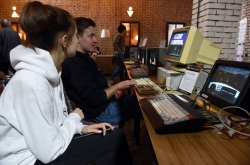Clothing is already much more than something we put on every day - in a sense, it has long become an important instrument of communication. People use clothing to express their preferences, outlook, personality - or, conversely, to hide within the crowd. Yet what will become of clothing in some 40 years? Will we be still referring to it as just "clothing"? Well, even if we will, we will definitely perceive it differently.
Let's try and imagine how that will be in 2055: one puts on his smart wear, goes outside, and while he's jogging or doing some other physical exercise, the fabric stretches so as to better stimulate the muscles, its texture changes according to the music he listens to and the emotions he feels, and so on. What’s more, everything he’s wearing has been printed on a 3D printer just that morning, and will be dissolved into raw material in the evening, so as to make it anew. All of this seems totally sci-fi like. Yet, it's all almost here.
Modern technologies already turn our clothing from the simple protective shell they are meant to be into a complex interface. Such costumes become something like information hubs that gather data on their owner. What's more, we even start to change our attitude towards our own bodies: people start to integrate technical parts into themselves. There already are several examples of such projects.

Fitness trackers that monitor one's biometric data or smart watches that can connect to smartphones are already seen as something common. Yet the range of opportunities constantly increases, and developers now aim to create some kind of a full-fledged autonomous life-support system. There are already projects on monitoring air condition; for instance, the Wearable clean air concept where the fabric absorbs polluted air and releases clean air. There are projects on storing energy, as well: they make use of the sun's energy or transform kinetic energy into electricity.
Smart materials that provide for temperature regulation are yet another field of research. The Nike AeroReact project is on special fibers that can "open" and "close" depending on the wearer's body temperature.
There are also gadgets and smart clothing that collects data on one's emotions, stress, heart rate and such. Some projects offer such solutions as meditation or breathing practices once they "notice" a problem, others collect data on the wearer’s state so as to vividly represent it. For instance, the Smart Second Skin Dress can release invigorating and sedative scents depending on its owner’s mood, and Intimacy 2.0's fabric changes its structure: it becomes more or less transparent depending on how its wearer feels.

Another trend is embedding technological parts into the fabric itself to make them invisible. A smart jacket by Ralph Lauren uses silver strings to monitor a sportsman's biometric data that it then sends to a coach. Google and Levi's work on a jacket with electronic strings. Those will be used as an additional interface for working with one’s smartphone: by touching the strings in a particular manner, one would give commands to his gadgets.
Yet, smart clothing is not all there's to it. There are now technologies that are to be embedded in one's body. Electronic and bio-sensing tattoos can trace one's body temperature and even things like glucose levels; the "tooth tattoo" developed at Princeton University can track the presence of hostile bacteria in one's mouth. More and more companies start working on new types of sensors that can be fixed in one's body, and in future, such things can well replace keys and passwords we use now.

It is obvious that such technologies aim to improve the work of services we use, yet, there's also the other side of the coin. Just ask yourself: how much data do we generate when gadgets gather every piece they can? Evgeniy Chereshev, former Head of Kaspersky Laboratory's Social Media Office, has recently conducted the following experiment: the subject was implanted with a chip in his arm and used it for two years - according to Eugeniy, the person wanted to feel as part of the Internet of Things - part of the technology. After the end of the experiment, the researcher was startled to find out how naive the person was about the informational trace he left. In fact, it was humongous: almost everything can be traced - from the force applied to a key on one's keyboard to the movement of one's eyes when browsing, not to mention such things as browser history and such. Another important issue is that given that one can forecast another's actions and behavior, it becomes easy to manipulate such a person. This is why, according to Evgeniy Chereshnev, data must belong to all the people and not particular corporations. The expert also believes that data protection has to be provided by special governmental agencies.
This leads us to a more serious kind of question: what if data becomes the new form of total control? As of now, there are even companies that develop solutions for such kinds of problems. For instance, there are projects such as eko Glasses - glasses that provide protection from face recognition systems.
Designers now also use biotechnologies to create artificial biological systems with targeted functionalties for producing clothing and footwear. English designers work on bio-footwear grown from artificial bacteria. Such footwear will ideally fit one's foot, as well as adapt to different conditions: for instance, if one starts running, it will change its structure by reacting to pressure. Surely, such footwear will have to be stored in special solutions - it will require as much attention from its owner as it gives to him in return.

Susan Lee, designer of another project, Biocouture, grows material from bacteria that live in green tea yeasts. The material takes the form of pieces of specific fabric that can be spliced without using threads. The designer has already used her new material for several items, and this is how the idea of bio-degradable clothing was born: one can grow a jacket at his house, then degrade it and use the material to make a new one next day.
More and more new technologies are being introduced in the fashion industry. For instance, 3D printing has already been used for several years now. At first, printed items were quite uncomfortable due to their texture, yet now designers have almost worked such problems out.
Fashion changes, and now one can see all kinds of bodies on the catwalk: obese, aged, disabled. Fashion is set to become more inclusive, and seeks to re-interpret our idea of the human body. Prosthetics becomes a new high-technology instrument. Actress and fashion model Aimee Mullins does not have both legs and uses a whole range of prostheses. She sees herself as an ideal human who can change her height. So, one can now definitely raise the issue of whether we can already see our limbs as removable media, or not? In the upcoming decades, the number of similar questions will only continue to grow.
What we've learned from WannaCry
The new WannaCry virus has recently made the headlines all around the world. The virus spread throughout the Net in only a few hours and affected both devices of common users and strategically significant hubs of different counties. Then, it turned out that the new virus was actually a redeveloped version of quite common cryptoware. Initially, it was intended to earn money in quite safe a way: by using the affected devices' capacities to produce bitcoins. Yet, the developers decided to take a step forward and tweak the program so it would earn directly.
As result, the virus was no more something that is designed to affect specific devices: after being uploaded to the Net, it started to disperse uncontrollably. Anyone who got infected and linked their computers to their corporate network infected both the network and all users who connected their private devices. This is how the virus spread to such a scale.

Thus, cybersecurity issues have now become a matter of a whole different level. If several years ago we couldn't even think that they can affect an individual’s life, now we see that they've become everyone’s problem.
So, why they are so dangerous? We don't always see the effects of the virus right after it starts functioning; thus, we miss the stage when we could prevent the system's failure. Such viruses need from several minutes to several hours to encrypt the information, and after they're done there is no way to return everything to normal.
This is, in a sense, a whole new social phenomena, as we are used to perceiving danger as something that has to do with some enemy at our borders - but there are no borders on the Net, and each can initiate and even become both the source and the victim of an attack.
What makes the current situation so troubling? As opposed to other viruses that make use of social engineering methods (the user is misinformed, and launches the virus by himself), WannaCry showed that viruses can infect devices by themselves.
Preciously, we believed that we can isolate ourselves from viruses, and most attacks were targeted at particular regions or companies. Now, viruses can search for vulnerabilities by themselves. We tend to forget that there are no borders to the Net, and isolating oneself will no longer work.
As for results, such large-scale attacks can lead to all kinds of events and disasters, as nowadays, almost everything works based on some information system. Viruses are believed to have caused a major train collision in France several years ago. An attack on the traffic control system resulted in a catastrophe that ended in leakage of hazardous chemicals.

So, how can we protect ourselves? There are three types of protection. Firstly, there are the antiviruses. Yet one has to understand that they appear after a virus has attacked, so they cannot protect from a new virus. Data back-up measures are also effective. If you don't want to buy some expensive solution, you can just use a removable hard drive to back up your data regularly. Cloud solutions are also great, as now many allow to rollback to previous versions of files. On a corporate level, companies can prohibit access to certain websites. That can not replace technical measures like using antiviruses, but can help nevertheless. And, surely, one just has to be on his guard. If you feel something is wrong, it is better to not dally and report what happened to the system administrator.






